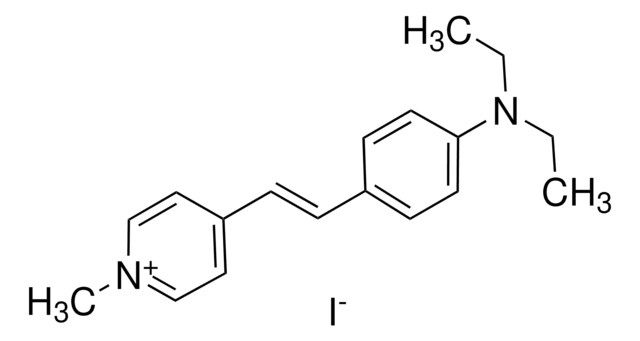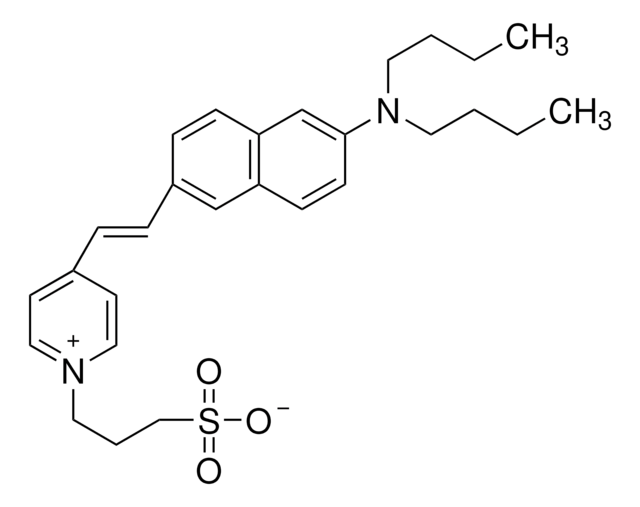D0815
2-[4-(Dimethylamino)styryl]-1-ethylpyridinium iodide
≥99% purity (HPLC), solid
Sinónimos:
DASPEI
About This Item
Productos recomendados
product name
2-[4-(Dimethylamino)styryl]-1-ethylpyridinium iodide, ≥99% (HPLC), solid
Nivel de calidad
Análisis
≥99% (HPLC)
formulario
solid
color
red
mp
267 °C (dec.) (lit.)
solubilidad
DMSO: 0.5 mg/mL
methanol: soluble
εmax
36.0-41.0 at 457-463 nm in methanol
aplicaciones
diagnostic assay manufacturing
hematology
histology
temp. de almacenamiento
2-8°C
cadena SMILES
[I-].CC[n+]1ccccc1\C=C\c2ccc(cc2)N(C)C
InChI
1S/C17H21N2.HI/c1-4-19-14-6-5-7-17(19)13-10-15-8-11-16(12-9-15)18(2)3;/h5-14H,4H2,1-3H3;1H/q+1;/p-1
Clave InChI
AMAXNNVXIBDEMV-UHFFFAOYSA-M
¿Está buscando productos similares? Visita Guía de comparación de productos
Aplicación
Acciones bioquímicas o fisiológicas
Código de clase de almacenamiento
11 - Combustible Solids
Clase de riesgo para el agua (WGK)
WGK 3
Punto de inflamabilidad (°F)
Not applicable
Punto de inflamabilidad (°C)
Not applicable
Equipo de protección personal
dust mask type N95 (US), Eyeshields, Gloves
Certificados de análisis (COA)
Busque Certificados de análisis (COA) introduciendo el número de lote del producto. Los números de lote se encuentran en la etiqueta del producto después de las palabras «Lot» o «Batch»
¿Ya tiene este producto?
Encuentre la documentación para los productos que ha comprado recientemente en la Biblioteca de documentos.
Nuestro equipo de científicos tiene experiencia en todas las áreas de investigación: Ciencias de la vida, Ciencia de los materiales, Síntesis química, Cromatografía, Analítica y muchas otras.
Póngase en contacto con el Servicio técnico
![trans-4-[4-(Dimethylamino)styryl]-1-methylpyridinium iodide Dye content 98 %](/deepweb/assets/sigmaaldrich/product/structures/416/722/5d59b6c3-5f2d-4396-a721-5cb82ba7038c/640/5d59b6c3-5f2d-4396-a721-5cb82ba7038c.png)
![4-[4-(Dimethylamino)styryl]pyridine 95%](/deepweb/assets/sigmaaldrich/product/structures/225/605/ad18cc93-9d43-467b-8618-105948f9692b/640/ad18cc93-9d43-467b-8618-105948f9692b.png)
![2-[4-(Dimethylamino)styryl]-N-methylbenzoxazolium perchlorate 99% (TLC)](/deepweb/assets/sigmaaldrich/product/structures/917/393/44ab3489-e929-4608-9398-791a2508734b/640/44ab3489-e929-4608-9398-791a2508734b.png)
![TRANS-4-[4-(DIBUTYLAMINO)STYRYL]-1-METHYLPYRIDINIUM IODIDE AldrichCPR](/deepweb/assets/sigmaaldrich/product/structures/316/860/49e4e927-ce25-4d51-b402-f30f828fdd24/640/49e4e927-ce25-4d51-b402-f30f828fdd24.png)




